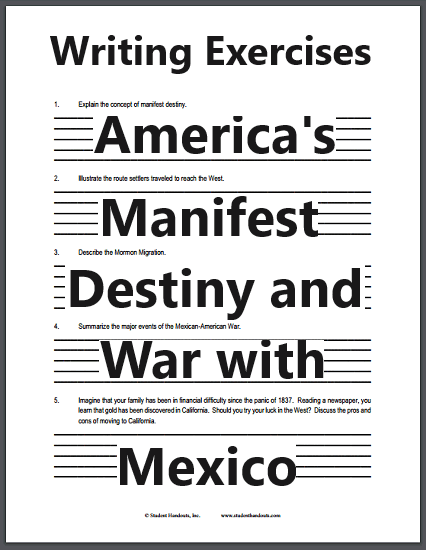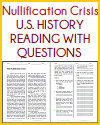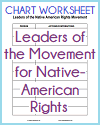| Manifest Destiny and War with Mexico Essay Questions |
|---|
| www.studenthandouts.com ↣ U.S. History ↣ Westward Expansion ↣ Worksheets |
 |
    |
|
1. Explain the concept of manifest destiny. Manifest Destiny was the 19th-century belief that the United States was destined by God to expand its territory across the entire North American continent. This ideology justified westward expansion, the annexation of territories, and the displacement of Native American tribes. Proponents saw it as spreading democracy and civilization, while critics viewed it as an excuse for aggressive imperialism and racial inequality. 2. Illustrate the route settlers traveled to reach the West. Settlers primarily traveled west via overland trails like the Oregon, California, and Santa Fe Trails. These routes began in Missouri river towns such as Independence, crossing the Great Plains and rugged mountains. The Mormon Trail followed a similar path to Utah. Later, transcontinental railroads offered a faster alternative. The journey was arduous, taking months by wagon, and was fraught with challenges like disease, harsh weather, and difficult terrain. 3. Describe the Mormon Migration. The Mormon Migration (1846-47) was the westward exodus of members of the Church of Jesus Christ of Latter-day Saints, fleeing religious persecution in Illinois. Led by Brigham Young after their founder's murder, they sought a remote sanctuary. Their arduous trek culminated in the settlement of the Salt Lake Valley in Utah, which became their permanent headquarters and a successful example of organized westward colonization. 4. Summarize the major events of the Mexican-American War. The Mexican-American War (1846-1848) began after a border dispute and the U.S. annexation of Texas. Key U.S. victories included the capture of Mexico City by Winfield Scott. The conflict ended with the Treaty of Guadalupe Hidalgo, in which Mexico ceded a vast territory, including California and New Mexico, to the United States. This acquisition significantly fulfilled the goals of Manifest Destiny but intensified sectional tensions over slavery. 5. Imagine that your family has been in financial difficulty since the panic of 1837. Reading a newspaper, you learn that gold has been discovered in California. Should you try your luck in the West? Discuss the pros and cons of moving to California. Moving to California in the mid-1800s, primarily for the Gold Rush, offered the potential for immense wealth and new opportunity. However, the journey was perilous, with risks of disease and accident. Upon arrival, prospectors often found scarce gold, high prices, lawlessness, and intense competition. While a few struck it rich, most faced harsh conditions and financial ruin, making it a high-risk venture for uncertain reward. Click here to print (PDF) this sheet of essay questions focused on America's Manifest Destiny and the Mexican-American War. Answers will vary. |
|
The Mormon Migration refers to the mass movement of members of The Church of Jesus Christ of Latter-day Saints (LDS Church), commonly known as Mormons, from the eastern United States to the Great Basin region in the western United States during the mid-19th century. This migration was a significant event in both Mormon history and the history of westward expansion in the United States.
Background: The LDS Church was founded by Joseph Smith in the 1820s in upstate New York. Smith claimed to have received divine revelations and translated the Book of Mormon, which became a foundational text for the church. As the church grew, its members faced persecution and hostility from their neighbors in various locations in the eastern United States, including New York, Ohio, Missouri, and Illinois. This persecution stemmed from religious differences, economic competition, and the church's practice of polygamy. In 1844, Joseph Smith was killed by a mob in Carthage, Illinois, which led to leadership struggles within the church. Leadership of Brigham Young: After Joseph Smith's death, leadership of the LDS Church passed to Brigham Young, who served as the president of the church. Recognizing the need to find a safe and isolated haven for the church's members, Brigham Young led the Mormons in their westward migration. Key Phases of the Migration:
Legacy: The Mormon Migration played a crucial role in the history of the American West and the settlement of the Great Basin. Today, the legacy of the Mormon pioneers is celebrated by members of the LDS Church, and the migration is commemorated as a significant chapter in the history of American religious freedom and westward expansion. |
| www.studenthandouts.com ↣ U.S. History ↣ Westward Expansion ↣ Worksheets |








